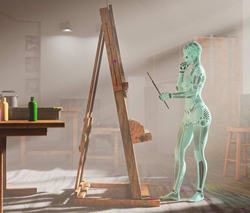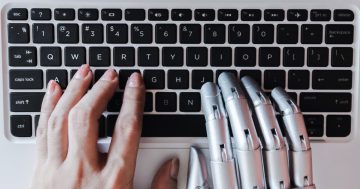We are on the cusp of a paradigm shift brought by generative AI — but it isn’t about making creativity “quick and easy.” Maya Ackerman says generative technology opens new heights of human expression and helps creators find their authentic voices.
 How we create is changing. The blog you read earlier today may have been made with generative AI.
How we create is changing. The blog you read earlier today may have been made with generative AI.
Within 10 years, most creative content will be produced with generative technologies.
The idea of using AI systems to create content is anything but new.
By the 1980s David Cope had already created EMI (Experiments in Musical Intelligence), which composed music in the style of Bach and Vivaldi, and Harold Cohen was showcasing artwork created by his system, AARON.
What is new is the long-overdue release of this technology from the ivory towers of academia and into the consumer market.
Perhaps the single largest push in the industry came from OpenAI, with a B2B approach that shares its large, multi-purpose generative models with a wide range of startups.
Some of the most popular include Copy.AI and Jasper, which focus on simplifying the writing of marketing copy, but GPT-3 is also powering stories, news articles (don’t worry, not this one!), and dialog systems, to name a few.
The impending release of DALL-E 2, a powerful text-to-image generator, will further expand opportunities for business-savvy entrepreneurs who would like to join the revolution without needing to develop their own technical IP.
While OpenAI is supplying firms with versatile technology, startups are out there providing value to consumers.
What is the role of generative AI in our everyday lives? What impact will it have on humanity at large and specifically our creative expression? What do consumers actually want from creative generative AI?
Deepening human creativity
It is true that generative methods can be targeted to reduce work opportunities for creative people, helping larger corporations make a few extra bucks.
But what I argue here is that this is actually a relatively weak opportunity.
There are plenty of creatives who already work for (more than) reasonable fees, and competing with the quality of their work remains very challenging for autonomous AI systems.
Generative AI has better uses than destroying jobs.
Humans have a profound need to express themselves, and we will continue to express ourselves until the end of time.
Consequently, the real opportunity in creative, generative technology is in deepening human creativity.
In fact, the original purpose of the creators of generative AI, including David Cope and Harold Cohen back in the 1980s, was precisely to enrich their own creative expression.
Since then, academics and technologically-savvy artists have been building systems to generate music, art and everything in between to enrich their own creative process.
This has been how creative AI has been used since its inception, and this is where its true potential lies.
I’ve been tackling the commercialization of generative AI since before the popularization of large generative models.
My team and I have been crafting new experiences from scratch, from the development of the generative AI models to the smallest UI/UX decisions.
This allowed us to gain profound insight into users’ needs in this emerging domain.
A partner in creativity
Identifying the key user need — the desire for deeper self-expression — made all the difference.
Users don’t want “quick and easy.”
They want to go deeper within themselves, to find the right words to express how they feel.
They want to be better artists, but only in a way that comes from finding new depths in their own unique creative expression.
Generative AI as a partner to help us find our authentic voice may seem like a contradiction.
But other technological advancements — from electric pianos and Photoshop to Digital audio workstations and Canva — have always been used to expand human expression.
Generative AI systems are no different.
In fact, by acting like a creative partner, generative AI is best positioned as a personalized guide to help us discover new layers of creative expression dormant within ourselves.
Before we wrap up, a final word of advice.
I love what OpenAI is doing for the industry.
But I would also like to encourage startups in the space not to shy away from developing your own AI.
OpenAI is powerful — but it is also general-purpose, and not ideal for any specific application.
For every unique domain, specialized generative technology can make a world of a difference to the user’s experience.
It will also make your startup that much more defensible against competition.
Seize the opportunity
Technology has long been used to speed up tasks and eliminate labour.
Perhaps we’ve forgotten that these were never the only aims of computing innovation.
When it comes to generative AI, the opportunities are a lot greater.
We have before us the chance to take human creativity to new heights.
The marriage of generative AI with the thriving new creator ecosystem is paving the way to a new world, ripe with opportunity that can only be compared with the tech boom of the 1990s.
The question isn’t whether generative AI will take over, but who will seize the opportunity early enough to shape the industry and reap the largest harvest.
*Maya Ackerman is Assistant Professor of Computer Science and Engineering at Santa Clara University and the CEO and cofounder of Silicon Valley startup WaveAI.
This article first appeared at venturebeat.com.








